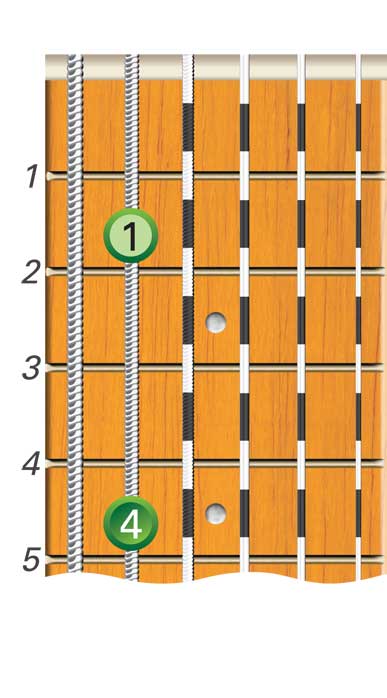
Rock Chords
When playing Rock or Blues styles, guitarists commonly use chords where only two strings are played. These two note chords are called Rock chords (also known as "Fifth chords" or "Power chords") and are useful as alternative shapes for major, sixth, and seventh chords.
A Rock Chord Shapes
The following diagrams show the two-string Rock chord shapes for A, A6 and A7. In all three chord shapes only the 5th and 4th strings are strummed.
A

A6

A7

The pale colored circle with the number 1 inside it indicates that you keep your 1st finger in position even though that note is not being played.
Play the following chord progression using these rock chord shapes. Use eighth note strums and only play the 5th and 4th strings. Use only down strums as this sounds better when playing the Rock chords in the following examples.


Play the previous examples as a two bar pattern.

D Rock Chord Shapes
The following diagrams show the two-string rock chord shapes for D, D6 and D7. Play only the 4th and 3rd strings.
D

D6

D7

Play the following two bar chord progression using the D rock chord shapes. Use only downward eighth note strums playing the 4th and 3rd strings only.

E Rock Chord Shapes
The following diagrams show the two-string rock chord shapes for E, E6 and E7. Play only the 6th and 5th strings
E

E6

E7

Play the following two bar chord progression using the previous rock chord shapes. Use only downward eighth note strums.

Play the following 12 Bar Blues in the key of A using rock chords. When there are two bars of a chord, use the two bar rock progressions you have just learned. E.g., for the A chord in bars 1 and 2, 3 and 4, 7 and 8, use the two bar progression in example 78.
For the D chord in bars 5 and 6, use the two bar progression in example 79. For each chord in the last four bars, substitute the first half of the rock chord progression. Try to play this 12 Bar Blues from memory. If you hope to play in a band or even jam with your friends, the ability to play songs from memory is an important skill to develop.





